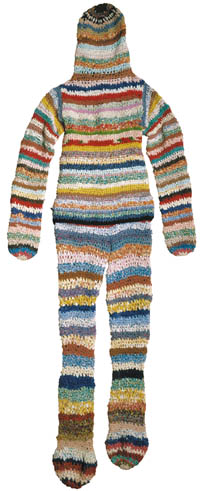Iím in the middle of this old photograph. Iím small and weak, surrounded by my extended family, full of life and strength, full of fun and happiness.
This is a photo of my cousin Borisís wedding in 1959 in the little town of Polevskoe in the province of Sverdlovsk. Many of those who are in the picture
have passed on by now. Their clothes were handed down to relatives. And when these old clothes finally get totally worn out, people tear them up into
long strips and knit little round rugs out of them. In houses in the Urals, every rug preserves the memory of the deceased, like a laser disc on which
our loved onesí voices and faces are recorded.
And so I asked my mother, whoíll be 85 this year, to knit me a suit from our familyís old clothes.
If you put it on, it protects you, it surrounds and embraces you like all my extended family in that old photo.
I named the suit Knitling. Now he is a new creature, created by the two main components of my art: the phenomena of time and place.
The Knitling preserves the warmth of the people in my village, making their memory tangible.
The old, worn-out vestments of my family are ripped to shreds, making long ribbons that are sewn together
end-to-end and wrapped around and around into a ball, like the magic ball of string that the prince follows in Russian fairy tales.
We turned the folk craft of the Urals into a magic ritual for calling back the spirits of our forefathers,
into the weaving of souls into an eternal spiral, into a solar sign, into a cocoon of memory, and the end result was a new mythical creature,
the knitted man, who joins the ranks of ancient surrealistic figures like the brownie in the cellar or the fairy in the garden.
|
 |


